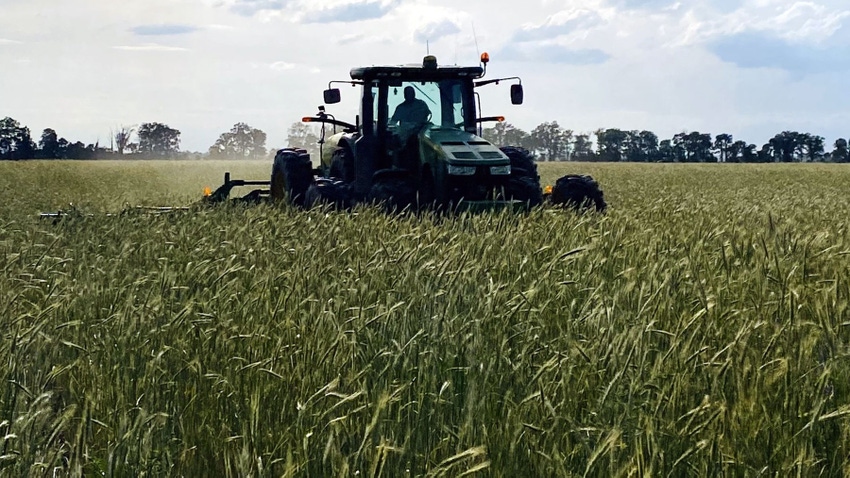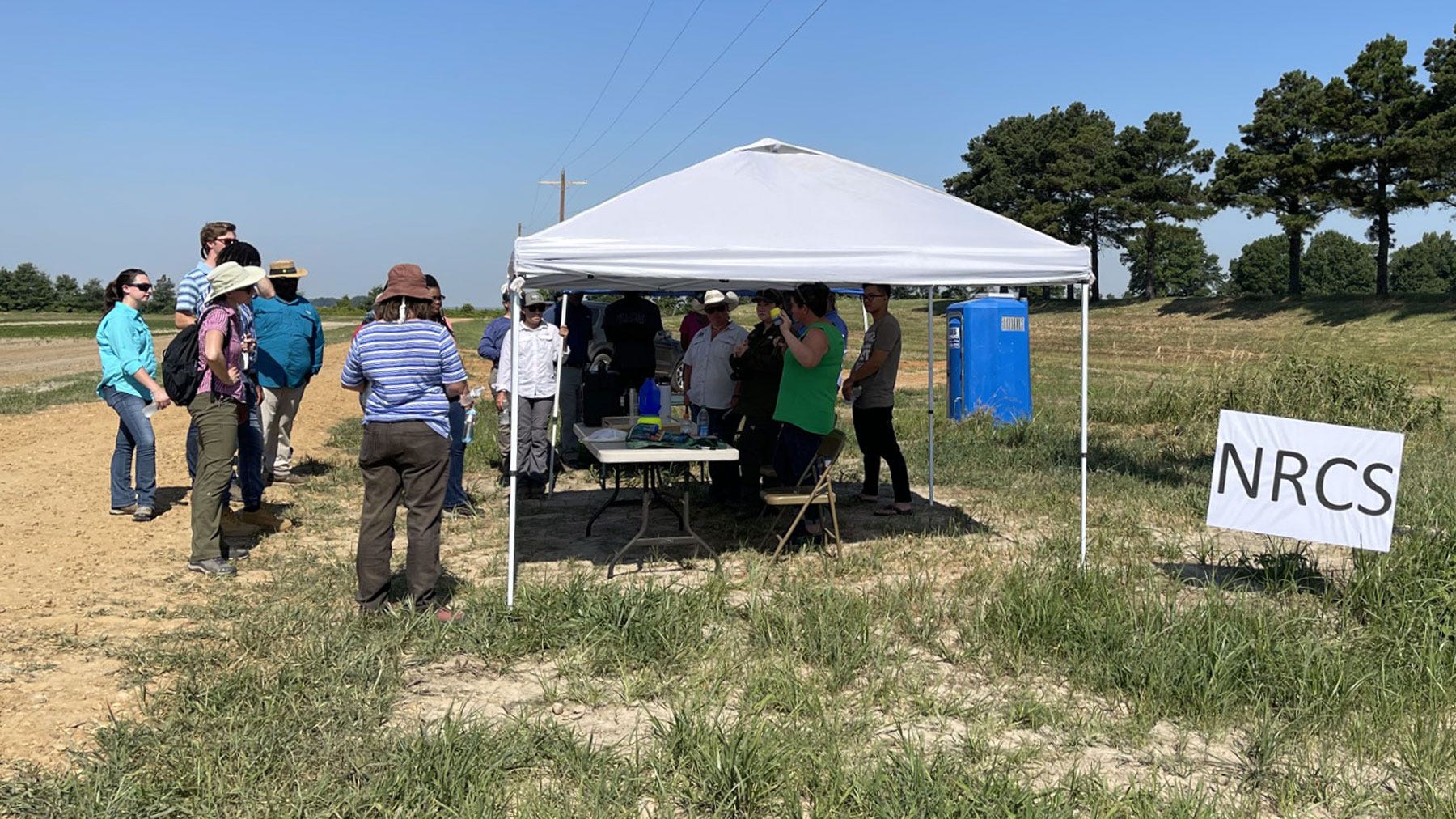
At a Glance
- Soil health advocates agree that education is key to embracing climate-smart practices.
- In some regions, cover crop producers experience challenges when competing for acres against nearby conventional producers.
- Researcher shares details on an educational project that demonstrates the advantages of soil health.
This is a continuation from a recent Farm Press article, Resources and Incentives for Conservation Cover Cropping, with more highlights from a cover crop meeting held this summer at Judd Hill Foundation Farm in northeast Arkansas.
Cover cropping and no-tilling are essential to a successful soil health management system. While these practices increase soil health, they can also look messy. The view from the turnrow is a sharp contrast from conventional agriculture, and soil health advocates agree that it takes a shift in mindset to accept the change.
An educational component is key to embracing climate-smart practices. This is true for producers, landowners, and ultimately the general population. Late this summer, farmers and conservation advocates met at the Judd Hill Foundation Farm in Poinsett County, Ark. for a discussion on soil health management systems.
They shared successes and obstacles of cover cropping. One specific topic arose, and participants nodded in agreement across the crowd: “Acreage competition is a challenge in the Delta for farmers focused on soil health.”
This obstacle comes from the outward appearance of what some call “ugly farming.” It also comes from the risk of yield lag on newly cover cropped acres – even if it brings a better return on investment (ROI) in the long run.
Tim Smith, owner of Southern Soil Solutions Inc., specializes in the sale of cover crop varieties and is a respected mentor in conservation ag. He said, “When it comes to soil health, the mindsets of landowners and farmers must switch from yield per acre to ROI.”
Challenge comes in acreage competition
In Poinsett County, Ark., Jesse Flye and Marty White have focused on soil health and cover cropping for the past three consecutive years. The first year, they had management challenges with the new system that lead to an initial loss of 400 pounds per acre of cotton planted into cover crops, compared to cotton right next to it grown with their conventional methods.
However, they modified their management and reported improvements in the years since. Last year, the yield loss was closer to 90 pounds of cotton per acre on the cover cropped ground. An additional cover crop study on the farm included livestock grazing, and it produced only 35 pounds of cotton less per acre – all compared to the average conventional cotton yield.
With this experience, Flye and White continue to fine tune their soil health management system. They noted that the initial yield loss could have been detrimental had their landowners not embraced it as an exchange for soil health. Also, it could have been problematic had they cover cropped too many acres too fast.
Flye said, “This is a highly competitive area. If I would have had the whole farm bring in 400 pounds of cotton less that first year, then it could have put me out of farming with the bank and with our landlords. At the end of the day, I have to hopefully cut our ROI with soil health management and pay the landowner the same amount of money.”
White affirmed they are fortunate to have understanding landowners who appreciate their conservation efforts. Johnathon Bobbitt, farmer in Craighead County, said the same of his experience.
Bobbitt is new to cover cropping. He grinned and said, “It was a scarry experience. This was our first year, but we will be back for more,” noting that most of his landowners are excited to build soil health.
However, acreage competition is a factor when production numbers slip. There is always the chance of losing those acres. The landowner may choose another producer to farm that ground the next year, and in some cases, there are landlords who refuse to have “ugly farming” on their acres.
Shifting the mindset with soil health education
There is a whole host of benefitts from this so called “ugly farming,” like an increase in soil microbial activity, a smaller carbon footprint, improved irrigation efficiency, and reduced chemical applications.
So, it begs the question, “How can we better educate about soil health to successfully shift mindsets toward conservation practices?”
Keith Scoggins, soil health specialist and Arkansas state agronomist at USDA-NRCS, said, “In order to move forward, we have to teach the younger generation to implement these climate-smart practices correctly from the start.
“We must also educate landowners to understand that producers are not doing this because it is the cool thing to do. Soil health management systems decrease erosion, decrease the hours the wells are running, and reduce the years between minimal tillage to reshape the beds in the fields.”
One such educational opportunity involves a research project on 35 acres at the Judd Hill Foundation Farm. It compares conservational practices to conventional farming techniques.

The research project at the Judd Hill Foundation Farm in northeast Arkansas is an educational opportunity open to anyone interested in learning the advantages of soil health management in row crop production. (Credit: Tina Gray Teague)
Tina Gray Teague, professor of entomology and plant science at Arkansas State University and the University of Arkansas System Division of Agriculture, spoke of the project.
“We have measured no yield reductions associated with cover crops. The project also includes monitoring efforts to examine effects on greenhouse gas. Additionally, with these replicated studies we see a 40% to 60% reduction in nutrient and sediment loss running off the field,” she said.
The research is funded by Cotton Incorporated in cooperation with the USDA-ARS Delta Water Management Research Unit in Jonesboro, Ark., and it is open to anyone of any age interested in learning more about conservation focused row crop production.
“We have used the experiment here at Judd Hill to bring in school aged children to talk about the benefits of soil and water conservation practices. We hope to expand the message that soil health benefits go beyond improving the land or a particular farm. These benefits improve the water quality of ditches and streams running into the Gulf of Mexico.”
As we move forward, perhaps we should remember not to judge a book by its cover – or better yet, a field by its cover. Soil health is more than what meets the eye. It is a win for the farmer, the landowner, and the world around us.
About the Author(s)
You May Also Like






